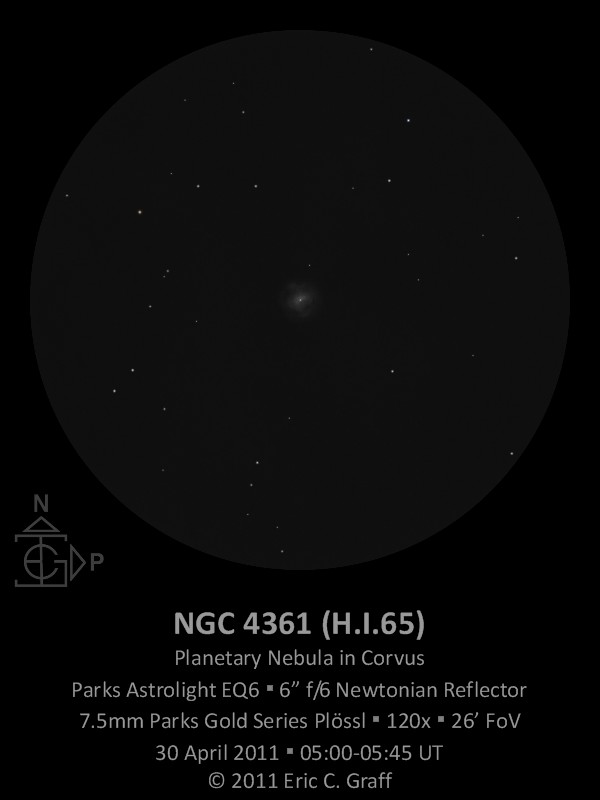Object Name: NGC 4361
Also Known As: H.I.65, PK 294+43 1, PN G294.1+43.6, VV 62
Object Type: Planetary Nebula
Constellation: Corvus
Right Ascension (2000.0): 12h 24m 30.8s
Declination (2000.0): –18° 47′ 05″
Magnitude: 10.3n/13.2s
Diameter: 45″/110″
Voronstov-Velyaminov Type: 3a+2
Distance: 2,600 light years
Discovery: William Herschel on 7 February 1785 with 18.7-inch reflector
NGC Description: vB, L, R, vsmbMN, r
Telescope: Parks Astrolight EQ6 • 6″ f/6 Newtonian Reflector
Eyepiece/Magnification: 7.5mm Parks Gold Series Plössl • 120x • 26′ Field of View
Filter: None
Date/Time: 30 April 2011 • 05:00-05:45 UT
Observing Location: Oakzanita Springs, Descanso, San Diego Co., California, USA
Transparency: NELM 6.2; TLM 14.1
Seeing: Pickering 7-8
Conditions: Clear, calm, cold, humid
I found this bright planetary nebula easily by sweeping 5° due east of my previous target, NGC 4038/9. If you are seeking this object out on its own, it lies in the northern portion of the keystone-like shape of the Crow, and forms a right triangle with Delta (δ) and Gamma (γ) Corvi. As the brightest deep-sky object in Corvus, it is faintly visible in 10×50 binoculars under a dark sky.
At 30x magnification, NGC 4361 appears as a small circular patch of colorless nebulosity with a brighter center in a field sprinkled with bright and faint stars. The central concentration, while prominent, could not clearly be resolved as the central star.
At 60x magnification NGC 4361 displays a bright inner ellipse in position angle 115° surrounded by a fainter outer halo. The central star is intermittently visible as a stellering in the center of the ellipse. Variations in brightness are suspected in the outer shell. At 120x magnification the central star is clearly and steadily visible, even with direct vision. The inner shell appears slightly brighter in its NE half, and faint spiral “arms” can be traced through the outer halo. The nebula remains colorless (or “white”) at each of these magnifications. In many ways this object looks a lot more like a galaxy than a planetary nebula through the eyepiece. At 240x magnification NGC 4361 appeared dim and very diffuse, with the 13th-magnitude central star blazing through the fog. This lack of definition prompted me to back the magnification down to 120x for the sketch.
At 120x magnification, most of the prominent stars visible in the low-power view have been pushed out of the field of view. Only TYC 6105-1027-1, yellow-orange, 8.7′ NE, and TYC 6105-1204-1, blue-white, 10′ NNW, both 11th-magnitude are bright enough to rival NGC 4361. The remaining field stars range from 12th down to 14th magnitude.
The sketch presented here depicts the view at high magnification (120x). The sketch has been rotated so that north is up and west is to the right. The sketch was produced with a No. 2 mechanical pencil with 0.5 mm lead, and three blending stumps (8948B, 8943B, and 8941B) on 100 lb. white card stock. The original drawing measures 7½ inches across.
This observation was made from a reasonably dark site (borderline blue-green on LP maps) at an elevation above 4,000 feet. The NELM was estimated at 6.2, the TLM at 14.1 in the vicinity of the target. The seeing conditions were above average (Pickering 7-8), but the humidity was quite high and care had to be taken to prevent dew from accumulating on optics and sketching materials. The temperature was 37°F. The air was very still and the high magnification views very steady.
Eric Graff


Eric, I loved your sketch, specially because it was done under almost the same conditions I do mine (except for the 4000 feet).
Eric,
Beautifully captured planetary and excellent narrative.
Frank 🙂